University Essay: Hope and Placebo in Counselling Practices
VerifiedAdded on 2023/01/19
|11
|3211
|55
Essay
AI Summary
This essay delves into the crucial roles of hope and the placebo effect within the realm of counselling, emphasizing their significance in enhancing patient outcomes. It begins by defining counselling and highlighting its increasing importance in addressing modern psychological challenges, then proceeds to explore various therapeutic approaches. The essay focuses on hope therapy and the placebo effect, examining their application, advantages, and the research supporting their efficacy in treating mental health issues such as anxiety, depression, and insomnia. It discusses how instilling hope and leveraging placebo interventions, including verbal cues and inert placebos, can significantly impact patients' beliefs, expectations, and ultimately, their recovery. The essay concludes by recommending the strategic integration of hope therapy and placebo effects, particularly in cases where pharmacological interventions are less effective, to maximize positive outcomes in counselling practices.
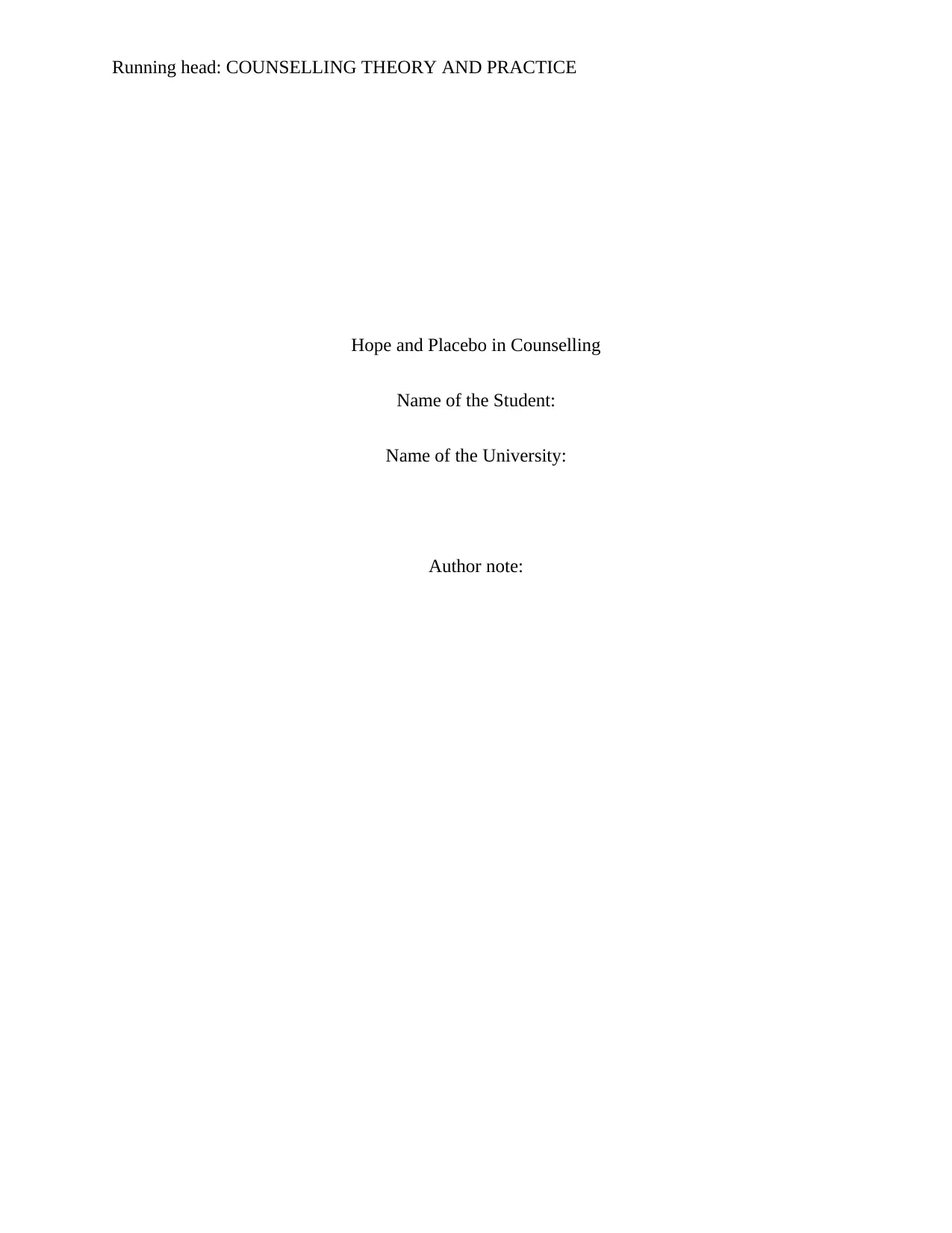
Running head: COUNSELLING THEORY AND PRACTICE
Hope and Placebo in Counselling
Name of the Student:
Name of the University:
Author note:
Hope and Placebo in Counselling
Name of the Student:
Name of the University:
Author note:
Paraphrase This Document
Need a fresh take? Get an instant paraphrase of this document with our AI Paraphraser
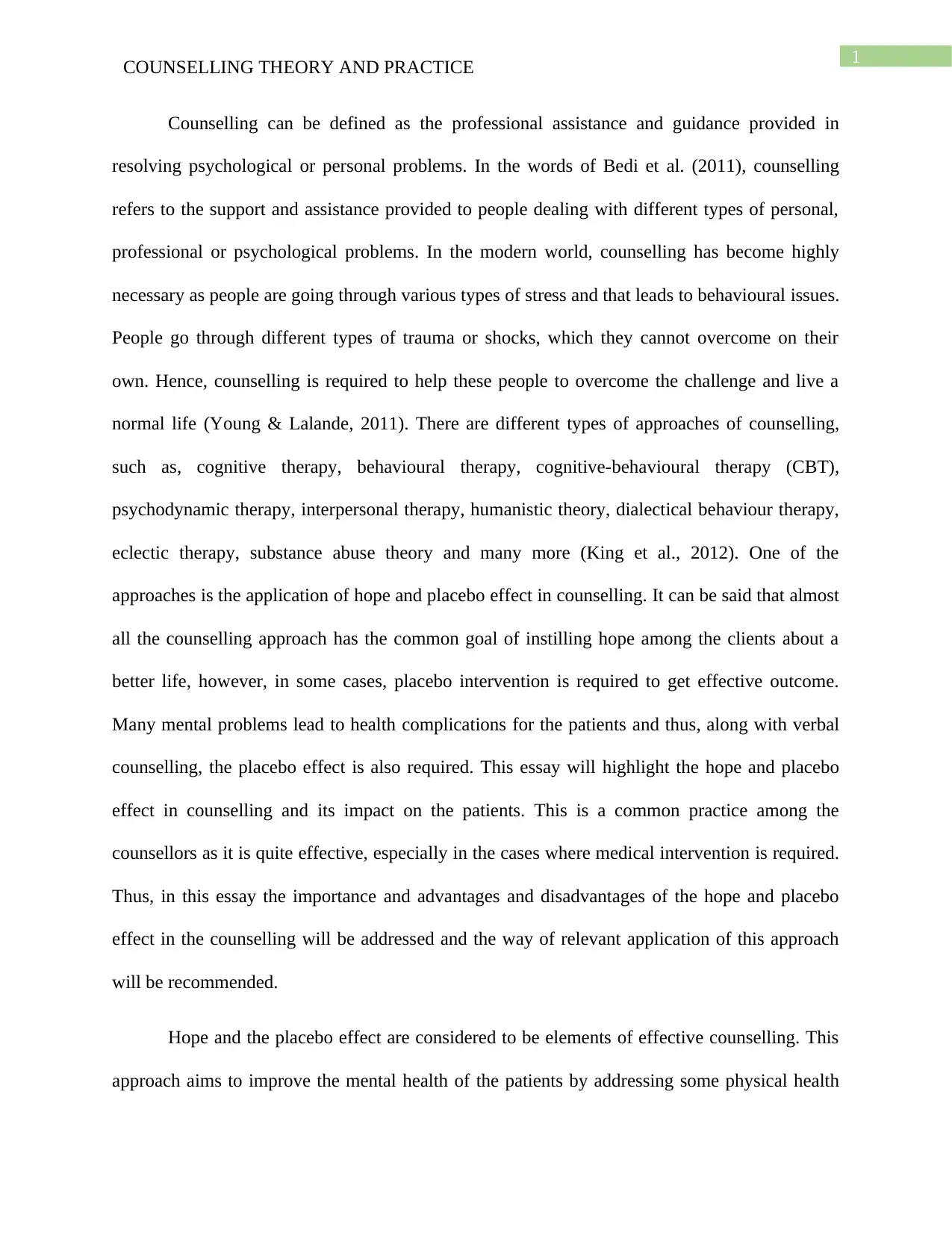
1
COUNSELLING THEORY AND PRACTICE
Counselling can be defined as the professional assistance and guidance provided in
resolving psychological or personal problems. In the words of Bedi et al. (2011), counselling
refers to the support and assistance provided to people dealing with different types of personal,
professional or psychological problems. In the modern world, counselling has become highly
necessary as people are going through various types of stress and that leads to behavioural issues.
People go through different types of trauma or shocks, which they cannot overcome on their
own. Hence, counselling is required to help these people to overcome the challenge and live a
normal life (Young & Lalande, 2011). There are different types of approaches of counselling,
such as, cognitive therapy, behavioural therapy, cognitive-behavioural therapy (CBT),
psychodynamic therapy, interpersonal therapy, humanistic theory, dialectical behaviour therapy,
eclectic therapy, substance abuse theory and many more (King et al., 2012). One of the
approaches is the application of hope and placebo effect in counselling. It can be said that almost
all the counselling approach has the common goal of instilling hope among the clients about a
better life, however, in some cases, placebo intervention is required to get effective outcome.
Many mental problems lead to health complications for the patients and thus, along with verbal
counselling, the placebo effect is also required. This essay will highlight the hope and placebo
effect in counselling and its impact on the patients. This is a common practice among the
counsellors as it is quite effective, especially in the cases where medical intervention is required.
Thus, in this essay the importance and advantages and disadvantages of the hope and placebo
effect in the counselling will be addressed and the way of relevant application of this approach
will be recommended.
Hope and the placebo effect are considered to be elements of effective counselling. This
approach aims to improve the mental health of the patients by addressing some physical health
COUNSELLING THEORY AND PRACTICE
Counselling can be defined as the professional assistance and guidance provided in
resolving psychological or personal problems. In the words of Bedi et al. (2011), counselling
refers to the support and assistance provided to people dealing with different types of personal,
professional or psychological problems. In the modern world, counselling has become highly
necessary as people are going through various types of stress and that leads to behavioural issues.
People go through different types of trauma or shocks, which they cannot overcome on their
own. Hence, counselling is required to help these people to overcome the challenge and live a
normal life (Young & Lalande, 2011). There are different types of approaches of counselling,
such as, cognitive therapy, behavioural therapy, cognitive-behavioural therapy (CBT),
psychodynamic therapy, interpersonal therapy, humanistic theory, dialectical behaviour therapy,
eclectic therapy, substance abuse theory and many more (King et al., 2012). One of the
approaches is the application of hope and placebo effect in counselling. It can be said that almost
all the counselling approach has the common goal of instilling hope among the clients about a
better life, however, in some cases, placebo intervention is required to get effective outcome.
Many mental problems lead to health complications for the patients and thus, along with verbal
counselling, the placebo effect is also required. This essay will highlight the hope and placebo
effect in counselling and its impact on the patients. This is a common practice among the
counsellors as it is quite effective, especially in the cases where medical intervention is required.
Thus, in this essay the importance and advantages and disadvantages of the hope and placebo
effect in the counselling will be addressed and the way of relevant application of this approach
will be recommended.
Hope and the placebo effect are considered to be elements of effective counselling. This
approach aims to improve the mental health of the patients by addressing some physical health
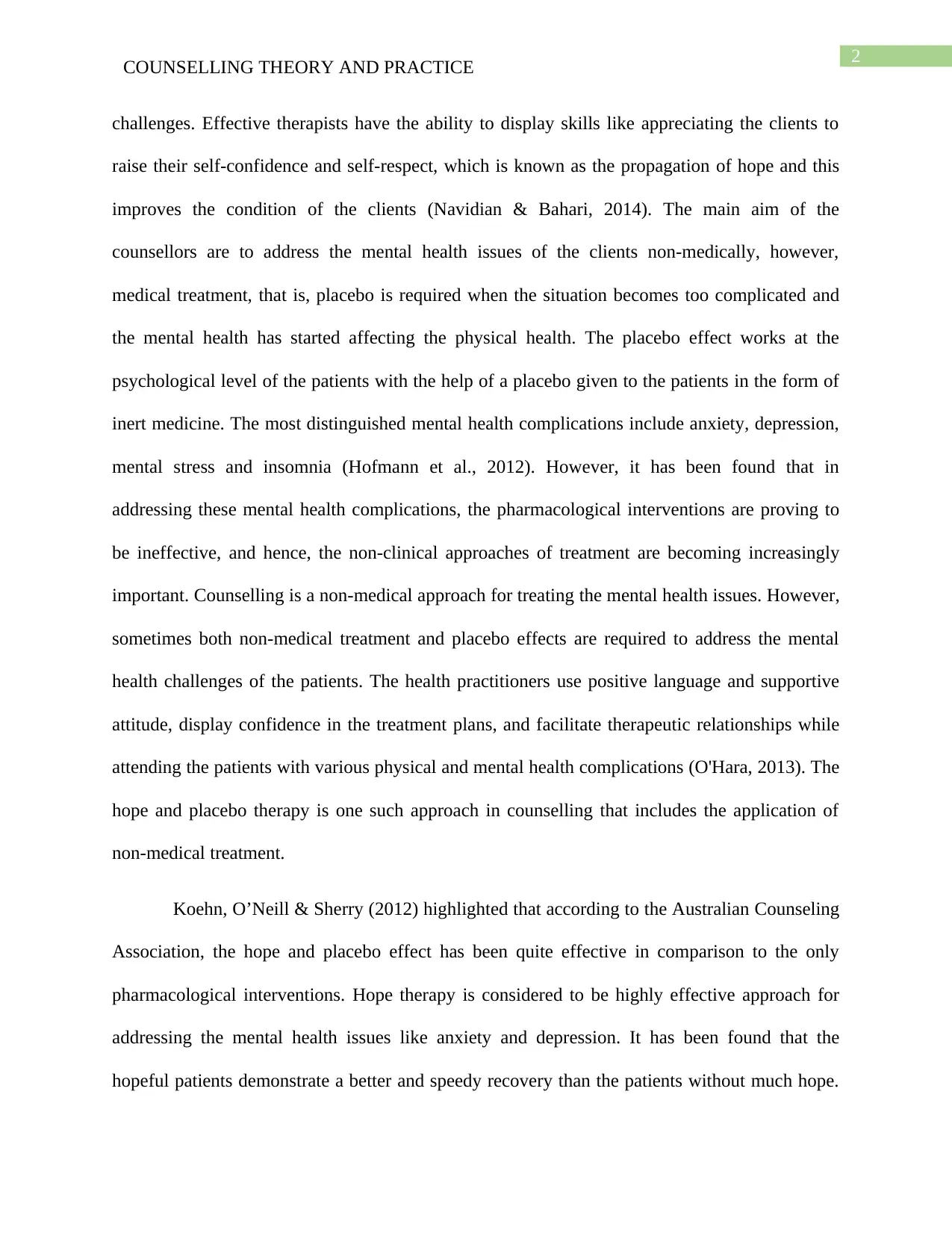
2
COUNSELLING THEORY AND PRACTICE
challenges. Effective therapists have the ability to display skills like appreciating the clients to
raise their self-confidence and self-respect, which is known as the propagation of hope and this
improves the condition of the clients (Navidian & Bahari, 2014). The main aim of the
counsellors are to address the mental health issues of the clients non-medically, however,
medical treatment, that is, placebo is required when the situation becomes too complicated and
the mental health has started affecting the physical health. The placebo effect works at the
psychological level of the patients with the help of a placebo given to the patients in the form of
inert medicine. The most distinguished mental health complications include anxiety, depression,
mental stress and insomnia (Hofmann et al., 2012). However, it has been found that in
addressing these mental health complications, the pharmacological interventions are proving to
be ineffective, and hence, the non-clinical approaches of treatment are becoming increasingly
important. Counselling is a non-medical approach for treating the mental health issues. However,
sometimes both non-medical treatment and placebo effects are required to address the mental
health challenges of the patients. The health practitioners use positive language and supportive
attitude, display confidence in the treatment plans, and facilitate therapeutic relationships while
attending the patients with various physical and mental health complications (O'Hara, 2013). The
hope and placebo therapy is one such approach in counselling that includes the application of
non-medical treatment.
Koehn, O’Neill & Sherry (2012) highlighted that according to the Australian Counseling
Association, the hope and placebo effect has been quite effective in comparison to the only
pharmacological interventions. Hope therapy is considered to be highly effective approach for
addressing the mental health issues like anxiety and depression. It has been found that the
hopeful patients demonstrate a better and speedy recovery than the patients without much hope.
COUNSELLING THEORY AND PRACTICE
challenges. Effective therapists have the ability to display skills like appreciating the clients to
raise their self-confidence and self-respect, which is known as the propagation of hope and this
improves the condition of the clients (Navidian & Bahari, 2014). The main aim of the
counsellors are to address the mental health issues of the clients non-medically, however,
medical treatment, that is, placebo is required when the situation becomes too complicated and
the mental health has started affecting the physical health. The placebo effect works at the
psychological level of the patients with the help of a placebo given to the patients in the form of
inert medicine. The most distinguished mental health complications include anxiety, depression,
mental stress and insomnia (Hofmann et al., 2012). However, it has been found that in
addressing these mental health complications, the pharmacological interventions are proving to
be ineffective, and hence, the non-clinical approaches of treatment are becoming increasingly
important. Counselling is a non-medical approach for treating the mental health issues. However,
sometimes both non-medical treatment and placebo effects are required to address the mental
health challenges of the patients. The health practitioners use positive language and supportive
attitude, display confidence in the treatment plans, and facilitate therapeutic relationships while
attending the patients with various physical and mental health complications (O'Hara, 2013). The
hope and placebo therapy is one such approach in counselling that includes the application of
non-medical treatment.
Koehn, O’Neill & Sherry (2012) highlighted that according to the Australian Counseling
Association, the hope and placebo effect has been quite effective in comparison to the only
pharmacological interventions. Hope therapy is considered to be highly effective approach for
addressing the mental health issues like anxiety and depression. It has been found that the
hopeful patients demonstrate a better and speedy recovery than the patients without much hope.
⊘ This is a preview!⊘
Do you want full access?
Subscribe today to unlock all pages.

Trusted by 1+ million students worldwide
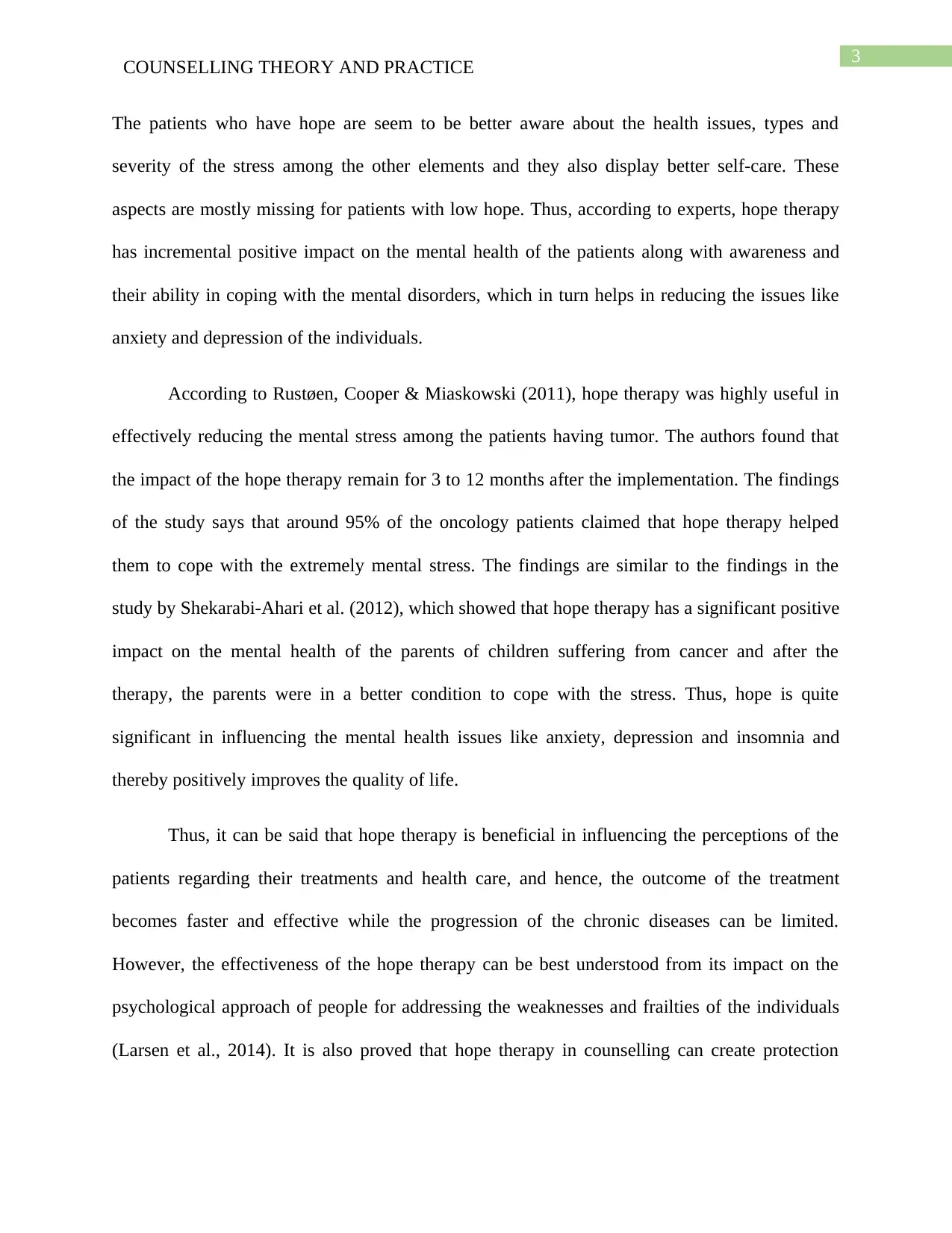
3
COUNSELLING THEORY AND PRACTICE
The patients who have hope are seem to be better aware about the health issues, types and
severity of the stress among the other elements and they also display better self-care. These
aspects are mostly missing for patients with low hope. Thus, according to experts, hope therapy
has incremental positive impact on the mental health of the patients along with awareness and
their ability in coping with the mental disorders, which in turn helps in reducing the issues like
anxiety and depression of the individuals.
According to Rustøen, Cooper & Miaskowski (2011), hope therapy was highly useful in
effectively reducing the mental stress among the patients having tumor. The authors found that
the impact of the hope therapy remain for 3 to 12 months after the implementation. The findings
of the study says that around 95% of the oncology patients claimed that hope therapy helped
them to cope with the extremely mental stress. The findings are similar to the findings in the
study by Shekarabi-Ahari et al. (2012), which showed that hope therapy has a significant positive
impact on the mental health of the parents of children suffering from cancer and after the
therapy, the parents were in a better condition to cope with the stress. Thus, hope is quite
significant in influencing the mental health issues like anxiety, depression and insomnia and
thereby positively improves the quality of life.
Thus, it can be said that hope therapy is beneficial in influencing the perceptions of the
patients regarding their treatments and health care, and hence, the outcome of the treatment
becomes faster and effective while the progression of the chronic diseases can be limited.
However, the effectiveness of the hope therapy can be best understood from its impact on the
psychological approach of people for addressing the weaknesses and frailties of the individuals
(Larsen et al., 2014). It is also proved that hope therapy in counselling can create protection
COUNSELLING THEORY AND PRACTICE
The patients who have hope are seem to be better aware about the health issues, types and
severity of the stress among the other elements and they also display better self-care. These
aspects are mostly missing for patients with low hope. Thus, according to experts, hope therapy
has incremental positive impact on the mental health of the patients along with awareness and
their ability in coping with the mental disorders, which in turn helps in reducing the issues like
anxiety and depression of the individuals.
According to Rustøen, Cooper & Miaskowski (2011), hope therapy was highly useful in
effectively reducing the mental stress among the patients having tumor. The authors found that
the impact of the hope therapy remain for 3 to 12 months after the implementation. The findings
of the study says that around 95% of the oncology patients claimed that hope therapy helped
them to cope with the extremely mental stress. The findings are similar to the findings in the
study by Shekarabi-Ahari et al. (2012), which showed that hope therapy has a significant positive
impact on the mental health of the parents of children suffering from cancer and after the
therapy, the parents were in a better condition to cope with the stress. Thus, hope is quite
significant in influencing the mental health issues like anxiety, depression and insomnia and
thereby positively improves the quality of life.
Thus, it can be said that hope therapy is beneficial in influencing the perceptions of the
patients regarding their treatments and health care, and hence, the outcome of the treatment
becomes faster and effective while the progression of the chronic diseases can be limited.
However, the effectiveness of the hope therapy can be best understood from its impact on the
psychological approach of people for addressing the weaknesses and frailties of the individuals
(Larsen et al., 2014). It is also proved that hope therapy in counselling can create protection
Paraphrase This Document
Need a fresh take? Get an instant paraphrase of this document with our AI Paraphraser

4
COUNSELLING THEORY AND PRACTICE
against various severe mental health issues, such as, anxiety and depression and can prevent
them from recurring.
On the other hand, placebo effect refers to the therapeutic impact on the subjects given
placebo. As stated by Meissner et al. (2011), placebo effect represents the changes in the
individuals due to placebo manipulation. Kirsch (2013) defines placebo as a substance or a
procedure which has no inherent power for producing an expected effect or outcome, that is, it is
a sham medical intervention exploiting or influencing the effect of hope or expectations from the
treatment. Placebo has a significant impact on the psychology or belief of the patients. The pill is
given to the patients that they are given a pill that would improve their condition, while the pill is
inert but the belief of the patients help them to recover. Thus, according to Meissner (2011),
placebo effect works as a psychological or physiological impact on the individuals due to
implementation of a substance or a procedure, but nor due to the inherent power of the substance
of procedure. Hence, placebos have indirect impact on the subjects.
In the counselling works, the placebo intervention is required to control the beliefs of the
patients to get effective outcome of the treatment. Placebos are used by the doctors for a long
time. Until the 1930s, the doctors used the placebos as substitutes of the pharmacological
interventions with high risks or reassuring the patients when no pharmacological interventions
was possible (Benedetti, 2013). Hence, placebos were a part of the clinical treatments for a long
time. However, with the improvements of the medical science, the definition of placebos
included inert control groups along with the inert pills and the scope of placebo effects increased.
Expectancy effects and context effects are also considered as placebo effects and hence, as stated
by Colloca et al. (2015), any particular medical or non-medical therapeutic intervention that
brings placebo effects is known as placebo.
COUNSELLING THEORY AND PRACTICE
against various severe mental health issues, such as, anxiety and depression and can prevent
them from recurring.
On the other hand, placebo effect refers to the therapeutic impact on the subjects given
placebo. As stated by Meissner et al. (2011), placebo effect represents the changes in the
individuals due to placebo manipulation. Kirsch (2013) defines placebo as a substance or a
procedure which has no inherent power for producing an expected effect or outcome, that is, it is
a sham medical intervention exploiting or influencing the effect of hope or expectations from the
treatment. Placebo has a significant impact on the psychology or belief of the patients. The pill is
given to the patients that they are given a pill that would improve their condition, while the pill is
inert but the belief of the patients help them to recover. Thus, according to Meissner (2011),
placebo effect works as a psychological or physiological impact on the individuals due to
implementation of a substance or a procedure, but nor due to the inherent power of the substance
of procedure. Hence, placebos have indirect impact on the subjects.
In the counselling works, the placebo intervention is required to control the beliefs of the
patients to get effective outcome of the treatment. Placebos are used by the doctors for a long
time. Until the 1930s, the doctors used the placebos as substitutes of the pharmacological
interventions with high risks or reassuring the patients when no pharmacological interventions
was possible (Benedetti, 2013). Hence, placebos were a part of the clinical treatments for a long
time. However, with the improvements of the medical science, the definition of placebos
included inert control groups along with the inert pills and the scope of placebo effects increased.
Expectancy effects and context effects are also considered as placebo effects and hence, as stated
by Colloca et al. (2015), any particular medical or non-medical therapeutic intervention that
brings placebo effects is known as placebo.
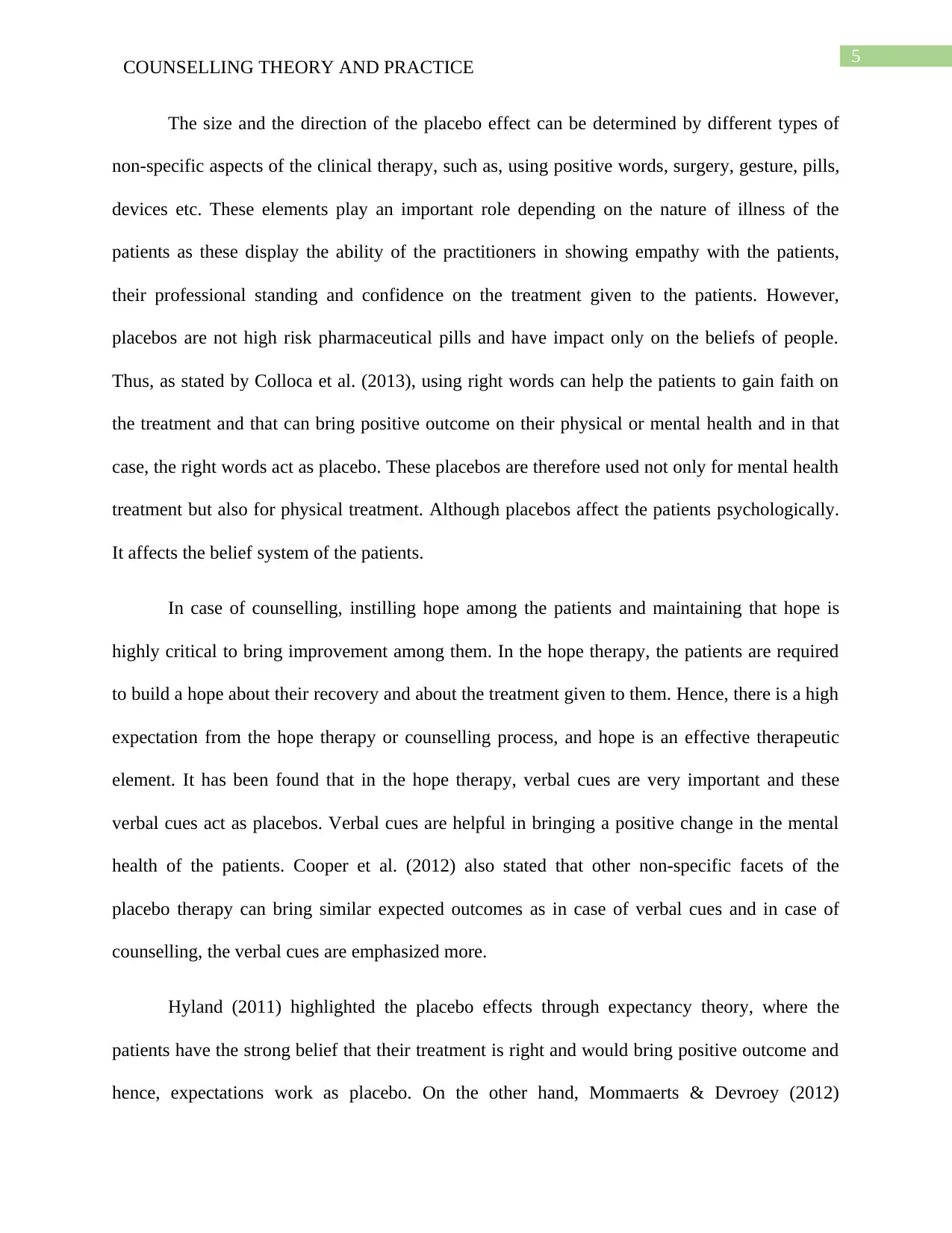
5
COUNSELLING THEORY AND PRACTICE
The size and the direction of the placebo effect can be determined by different types of
non-specific aspects of the clinical therapy, such as, using positive words, surgery, gesture, pills,
devices etc. These elements play an important role depending on the nature of illness of the
patients as these display the ability of the practitioners in showing empathy with the patients,
their professional standing and confidence on the treatment given to the patients. However,
placebos are not high risk pharmaceutical pills and have impact only on the beliefs of people.
Thus, as stated by Colloca et al. (2013), using right words can help the patients to gain faith on
the treatment and that can bring positive outcome on their physical or mental health and in that
case, the right words act as placebo. These placebos are therefore used not only for mental health
treatment but also for physical treatment. Although placebos affect the patients psychologically.
It affects the belief system of the patients.
In case of counselling, instilling hope among the patients and maintaining that hope is
highly critical to bring improvement among them. In the hope therapy, the patients are required
to build a hope about their recovery and about the treatment given to them. Hence, there is a high
expectation from the hope therapy or counselling process, and hope is an effective therapeutic
element. It has been found that in the hope therapy, verbal cues are very important and these
verbal cues act as placebos. Verbal cues are helpful in bringing a positive change in the mental
health of the patients. Cooper et al. (2012) also stated that other non-specific facets of the
placebo therapy can bring similar expected outcomes as in case of verbal cues and in case of
counselling, the verbal cues are emphasized more.
Hyland (2011) highlighted the placebo effects through expectancy theory, where the
patients have the strong belief that their treatment is right and would bring positive outcome and
hence, expectations work as placebo. On the other hand, Mommaerts & Devroey (2012)
COUNSELLING THEORY AND PRACTICE
The size and the direction of the placebo effect can be determined by different types of
non-specific aspects of the clinical therapy, such as, using positive words, surgery, gesture, pills,
devices etc. These elements play an important role depending on the nature of illness of the
patients as these display the ability of the practitioners in showing empathy with the patients,
their professional standing and confidence on the treatment given to the patients. However,
placebos are not high risk pharmaceutical pills and have impact only on the beliefs of people.
Thus, as stated by Colloca et al. (2013), using right words can help the patients to gain faith on
the treatment and that can bring positive outcome on their physical or mental health and in that
case, the right words act as placebo. These placebos are therefore used not only for mental health
treatment but also for physical treatment. Although placebos affect the patients psychologically.
It affects the belief system of the patients.
In case of counselling, instilling hope among the patients and maintaining that hope is
highly critical to bring improvement among them. In the hope therapy, the patients are required
to build a hope about their recovery and about the treatment given to them. Hence, there is a high
expectation from the hope therapy or counselling process, and hope is an effective therapeutic
element. It has been found that in the hope therapy, verbal cues are very important and these
verbal cues act as placebos. Verbal cues are helpful in bringing a positive change in the mental
health of the patients. Cooper et al. (2012) also stated that other non-specific facets of the
placebo therapy can bring similar expected outcomes as in case of verbal cues and in case of
counselling, the verbal cues are emphasized more.
Hyland (2011) highlighted the placebo effects through expectancy theory, where the
patients have the strong belief that their treatment is right and would bring positive outcome and
hence, expectations work as placebo. On the other hand, Mommaerts & Devroey (2012)
⊘ This is a preview!⊘
Do you want full access?
Subscribe today to unlock all pages.

Trusted by 1+ million students worldwide
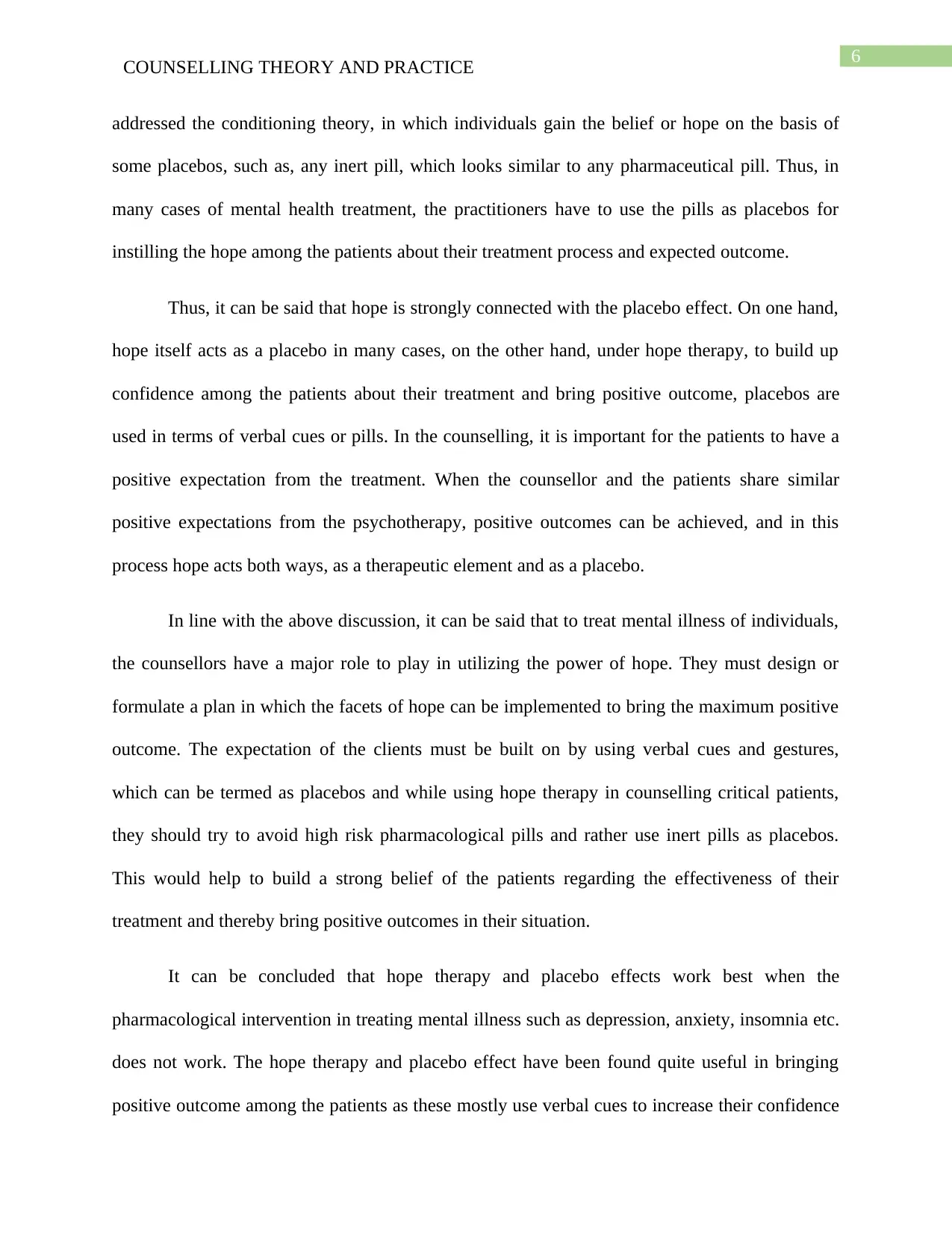
6
COUNSELLING THEORY AND PRACTICE
addressed the conditioning theory, in which individuals gain the belief or hope on the basis of
some placebos, such as, any inert pill, which looks similar to any pharmaceutical pill. Thus, in
many cases of mental health treatment, the practitioners have to use the pills as placebos for
instilling the hope among the patients about their treatment process and expected outcome.
Thus, it can be said that hope is strongly connected with the placebo effect. On one hand,
hope itself acts as a placebo in many cases, on the other hand, under hope therapy, to build up
confidence among the patients about their treatment and bring positive outcome, placebos are
used in terms of verbal cues or pills. In the counselling, it is important for the patients to have a
positive expectation from the treatment. When the counsellor and the patients share similar
positive expectations from the psychotherapy, positive outcomes can be achieved, and in this
process hope acts both ways, as a therapeutic element and as a placebo.
In line with the above discussion, it can be said that to treat mental illness of individuals,
the counsellors have a major role to play in utilizing the power of hope. They must design or
formulate a plan in which the facets of hope can be implemented to bring the maximum positive
outcome. The expectation of the clients must be built on by using verbal cues and gestures,
which can be termed as placebos and while using hope therapy in counselling critical patients,
they should try to avoid high risk pharmacological pills and rather use inert pills as placebos.
This would help to build a strong belief of the patients regarding the effectiveness of their
treatment and thereby bring positive outcomes in their situation.
It can be concluded that hope therapy and placebo effects work best when the
pharmacological intervention in treating mental illness such as depression, anxiety, insomnia etc.
does not work. The hope therapy and placebo effect have been found quite useful in bringing
positive outcome among the patients as these mostly use verbal cues to increase their confidence
COUNSELLING THEORY AND PRACTICE
addressed the conditioning theory, in which individuals gain the belief or hope on the basis of
some placebos, such as, any inert pill, which looks similar to any pharmaceutical pill. Thus, in
many cases of mental health treatment, the practitioners have to use the pills as placebos for
instilling the hope among the patients about their treatment process and expected outcome.
Thus, it can be said that hope is strongly connected with the placebo effect. On one hand,
hope itself acts as a placebo in many cases, on the other hand, under hope therapy, to build up
confidence among the patients about their treatment and bring positive outcome, placebos are
used in terms of verbal cues or pills. In the counselling, it is important for the patients to have a
positive expectation from the treatment. When the counsellor and the patients share similar
positive expectations from the psychotherapy, positive outcomes can be achieved, and in this
process hope acts both ways, as a therapeutic element and as a placebo.
In line with the above discussion, it can be said that to treat mental illness of individuals,
the counsellors have a major role to play in utilizing the power of hope. They must design or
formulate a plan in which the facets of hope can be implemented to bring the maximum positive
outcome. The expectation of the clients must be built on by using verbal cues and gestures,
which can be termed as placebos and while using hope therapy in counselling critical patients,
they should try to avoid high risk pharmacological pills and rather use inert pills as placebos.
This would help to build a strong belief of the patients regarding the effectiveness of their
treatment and thereby bring positive outcomes in their situation.
It can be concluded that hope therapy and placebo effects work best when the
pharmacological intervention in treating mental illness such as depression, anxiety, insomnia etc.
does not work. The hope therapy and placebo effect have been found quite useful in bringing
positive outcome among the patients as these mostly use verbal cues to increase their confidence
Paraphrase This Document
Need a fresh take? Get an instant paraphrase of this document with our AI Paraphraser
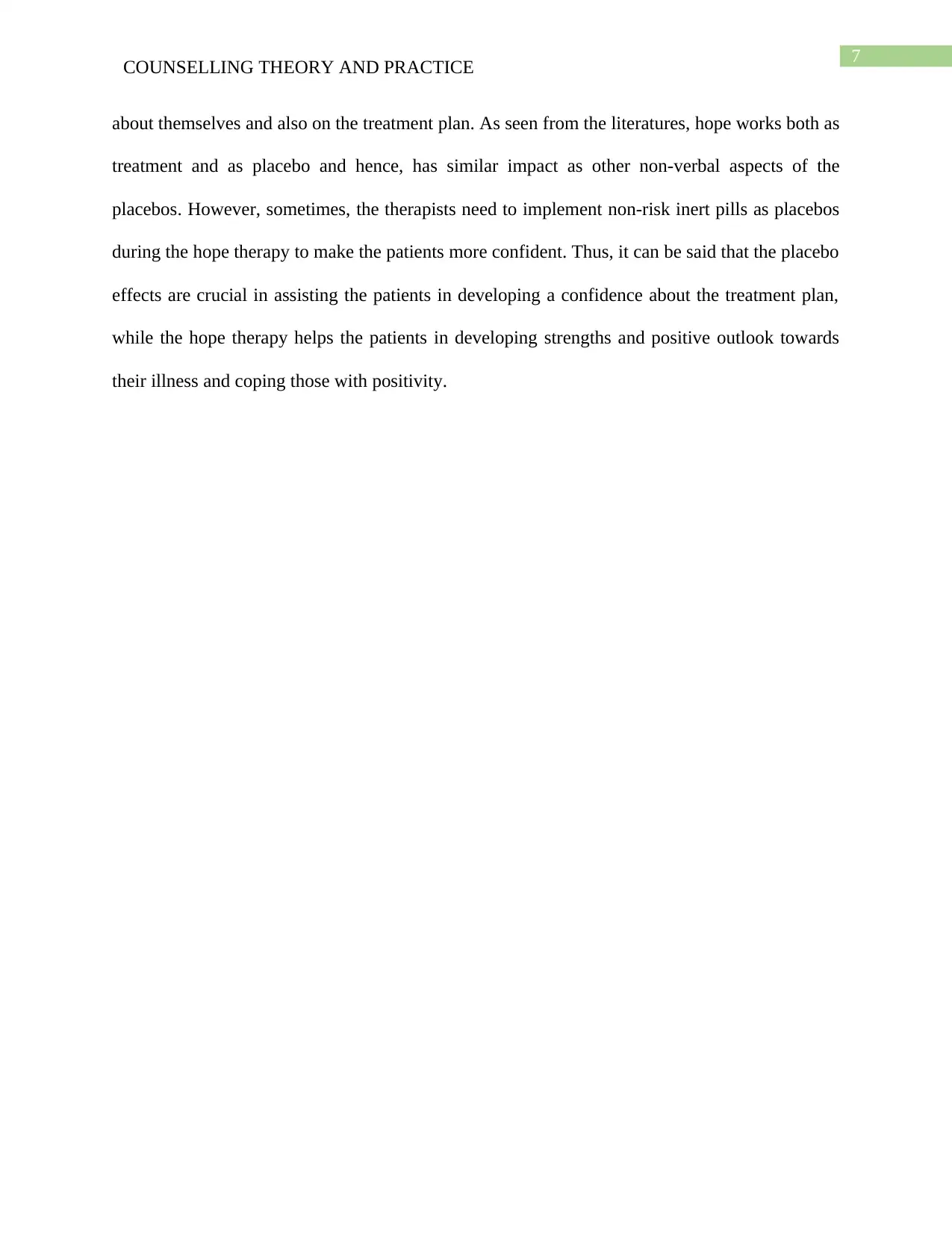
7
COUNSELLING THEORY AND PRACTICE
about themselves and also on the treatment plan. As seen from the literatures, hope works both as
treatment and as placebo and hence, has similar impact as other non-verbal aspects of the
placebos. However, sometimes, the therapists need to implement non-risk inert pills as placebos
during the hope therapy to make the patients more confident. Thus, it can be said that the placebo
effects are crucial in assisting the patients in developing a confidence about the treatment plan,
while the hope therapy helps the patients in developing strengths and positive outlook towards
their illness and coping those with positivity.
COUNSELLING THEORY AND PRACTICE
about themselves and also on the treatment plan. As seen from the literatures, hope works both as
treatment and as placebo and hence, has similar impact as other non-verbal aspects of the
placebos. However, sometimes, the therapists need to implement non-risk inert pills as placebos
during the hope therapy to make the patients more confident. Thus, it can be said that the placebo
effects are crucial in assisting the patients in developing a confidence about the treatment plan,
while the hope therapy helps the patients in developing strengths and positive outlook towards
their illness and coping those with positivity.
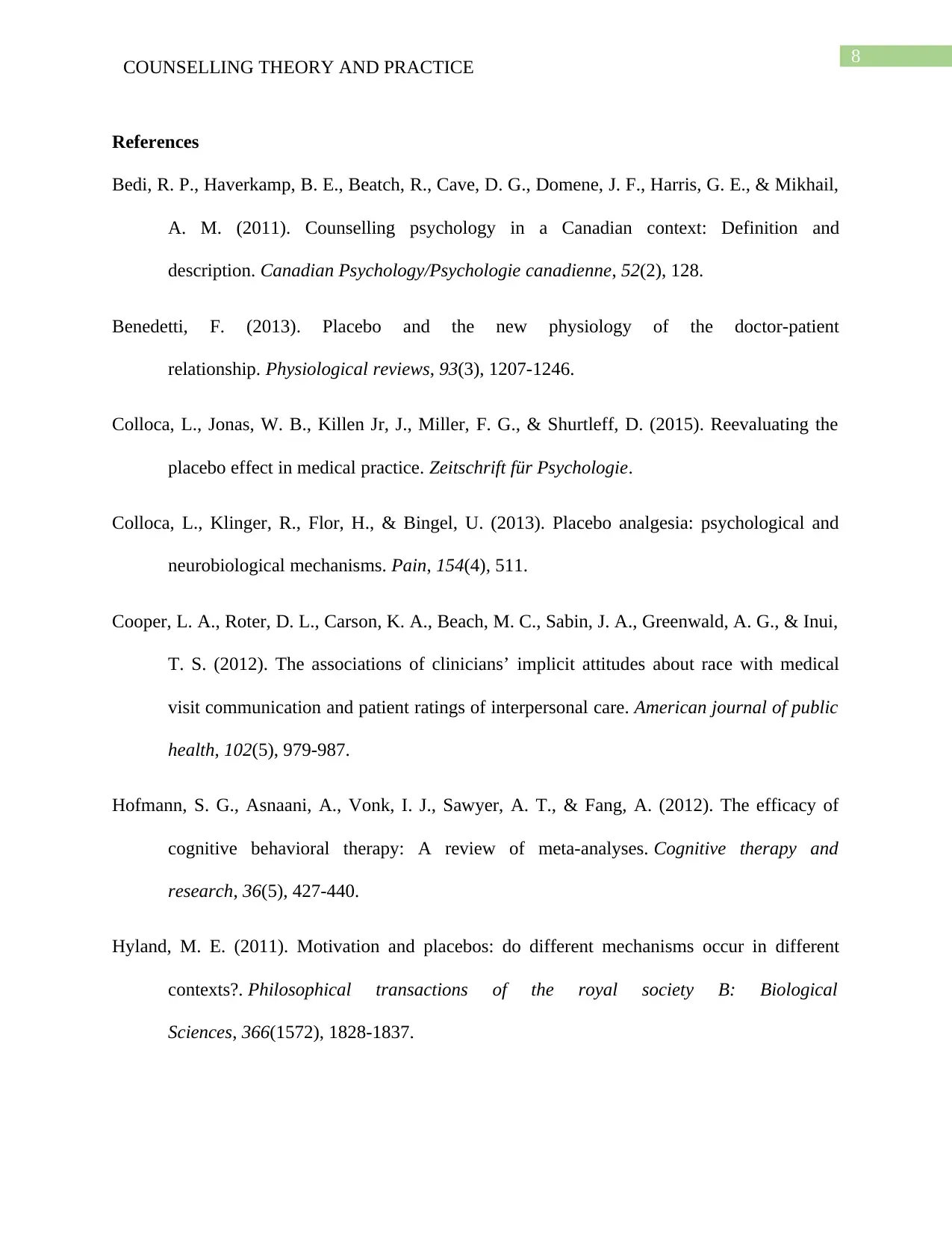
8
COUNSELLING THEORY AND PRACTICE
References
Bedi, R. P., Haverkamp, B. E., Beatch, R., Cave, D. G., Domene, J. F., Harris, G. E., & Mikhail,
A. M. (2011). Counselling psychology in a Canadian context: Definition and
description. Canadian Psychology/Psychologie canadienne, 52(2), 128.
Benedetti, F. (2013). Placebo and the new physiology of the doctor-patient
relationship. Physiological reviews, 93(3), 1207-1246.
Colloca, L., Jonas, W. B., Killen Jr, J., Miller, F. G., & Shurtleff, D. (2015). Reevaluating the
placebo effect in medical practice. Zeitschrift für Psychologie.
Colloca, L., Klinger, R., Flor, H., & Bingel, U. (2013). Placebo analgesia: psychological and
neurobiological mechanisms. Pain, 154(4), 511.
Cooper, L. A., Roter, D. L., Carson, K. A., Beach, M. C., Sabin, J. A., Greenwald, A. G., & Inui,
T. S. (2012). The associations of clinicians’ implicit attitudes about race with medical
visit communication and patient ratings of interpersonal care. American journal of public
health, 102(5), 979-987.
Hofmann, S. G., Asnaani, A., Vonk, I. J., Sawyer, A. T., & Fang, A. (2012). The efficacy of
cognitive behavioral therapy: A review of meta-analyses. Cognitive therapy and
research, 36(5), 427-440.
Hyland, M. E. (2011). Motivation and placebos: do different mechanisms occur in different
contexts?. Philosophical transactions of the royal society B: Biological
Sciences, 366(1572), 1828-1837.
COUNSELLING THEORY AND PRACTICE
References
Bedi, R. P., Haverkamp, B. E., Beatch, R., Cave, D. G., Domene, J. F., Harris, G. E., & Mikhail,
A. M. (2011). Counselling psychology in a Canadian context: Definition and
description. Canadian Psychology/Psychologie canadienne, 52(2), 128.
Benedetti, F. (2013). Placebo and the new physiology of the doctor-patient
relationship. Physiological reviews, 93(3), 1207-1246.
Colloca, L., Jonas, W. B., Killen Jr, J., Miller, F. G., & Shurtleff, D. (2015). Reevaluating the
placebo effect in medical practice. Zeitschrift für Psychologie.
Colloca, L., Klinger, R., Flor, H., & Bingel, U. (2013). Placebo analgesia: psychological and
neurobiological mechanisms. Pain, 154(4), 511.
Cooper, L. A., Roter, D. L., Carson, K. A., Beach, M. C., Sabin, J. A., Greenwald, A. G., & Inui,
T. S. (2012). The associations of clinicians’ implicit attitudes about race with medical
visit communication and patient ratings of interpersonal care. American journal of public
health, 102(5), 979-987.
Hofmann, S. G., Asnaani, A., Vonk, I. J., Sawyer, A. T., & Fang, A. (2012). The efficacy of
cognitive behavioral therapy: A review of meta-analyses. Cognitive therapy and
research, 36(5), 427-440.
Hyland, M. E. (2011). Motivation and placebos: do different mechanisms occur in different
contexts?. Philosophical transactions of the royal society B: Biological
Sciences, 366(1572), 1828-1837.
⊘ This is a preview!⊘
Do you want full access?
Subscribe today to unlock all pages.

Trusted by 1+ million students worldwide
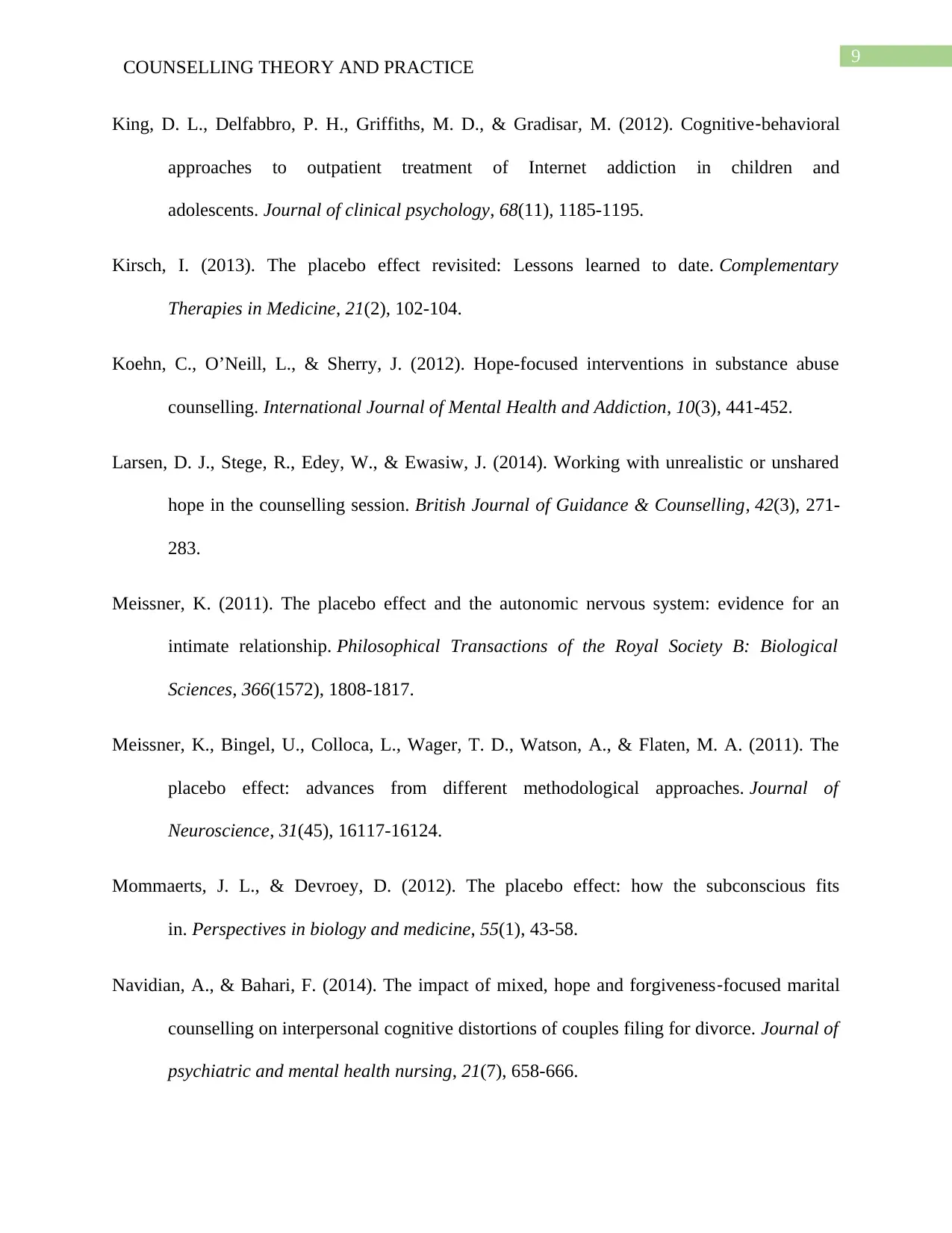
9
COUNSELLING THEORY AND PRACTICE
King, D. L., Delfabbro, P. H., Griffiths, M. D., & Gradisar, M. (2012). Cognitive‐behavioral
approaches to outpatient treatment of Internet addiction in children and
adolescents. Journal of clinical psychology, 68(11), 1185-1195.
Kirsch, I. (2013). The placebo effect revisited: Lessons learned to date. Complementary
Therapies in Medicine, 21(2), 102-104.
Koehn, C., O’Neill, L., & Sherry, J. (2012). Hope-focused interventions in substance abuse
counselling. International Journal of Mental Health and Addiction, 10(3), 441-452.
Larsen, D. J., Stege, R., Edey, W., & Ewasiw, J. (2014). Working with unrealistic or unshared
hope in the counselling session. British Journal of Guidance & Counselling, 42(3), 271-
283.
Meissner, K. (2011). The placebo effect and the autonomic nervous system: evidence for an
intimate relationship. Philosophical Transactions of the Royal Society B: Biological
Sciences, 366(1572), 1808-1817.
Meissner, K., Bingel, U., Colloca, L., Wager, T. D., Watson, A., & Flaten, M. A. (2011). The
placebo effect: advances from different methodological approaches. Journal of
Neuroscience, 31(45), 16117-16124.
Mommaerts, J. L., & Devroey, D. (2012). The placebo effect: how the subconscious fits
in. Perspectives in biology and medicine, 55(1), 43-58.
Navidian, A., & Bahari, F. (2014). The impact of mixed, hope and forgiveness‐focused marital
counselling on interpersonal cognitive distortions of couples filing for divorce. Journal of
psychiatric and mental health nursing, 21(7), 658-666.
COUNSELLING THEORY AND PRACTICE
King, D. L., Delfabbro, P. H., Griffiths, M. D., & Gradisar, M. (2012). Cognitive‐behavioral
approaches to outpatient treatment of Internet addiction in children and
adolescents. Journal of clinical psychology, 68(11), 1185-1195.
Kirsch, I. (2013). The placebo effect revisited: Lessons learned to date. Complementary
Therapies in Medicine, 21(2), 102-104.
Koehn, C., O’Neill, L., & Sherry, J. (2012). Hope-focused interventions in substance abuse
counselling. International Journal of Mental Health and Addiction, 10(3), 441-452.
Larsen, D. J., Stege, R., Edey, W., & Ewasiw, J. (2014). Working with unrealistic or unshared
hope in the counselling session. British Journal of Guidance & Counselling, 42(3), 271-
283.
Meissner, K. (2011). The placebo effect and the autonomic nervous system: evidence for an
intimate relationship. Philosophical Transactions of the Royal Society B: Biological
Sciences, 366(1572), 1808-1817.
Meissner, K., Bingel, U., Colloca, L., Wager, T. D., Watson, A., & Flaten, M. A. (2011). The
placebo effect: advances from different methodological approaches. Journal of
Neuroscience, 31(45), 16117-16124.
Mommaerts, J. L., & Devroey, D. (2012). The placebo effect: how the subconscious fits
in. Perspectives in biology and medicine, 55(1), 43-58.
Navidian, A., & Bahari, F. (2014). The impact of mixed, hope and forgiveness‐focused marital
counselling on interpersonal cognitive distortions of couples filing for divorce. Journal of
psychiatric and mental health nursing, 21(7), 658-666.
Paraphrase This Document
Need a fresh take? Get an instant paraphrase of this document with our AI Paraphraser
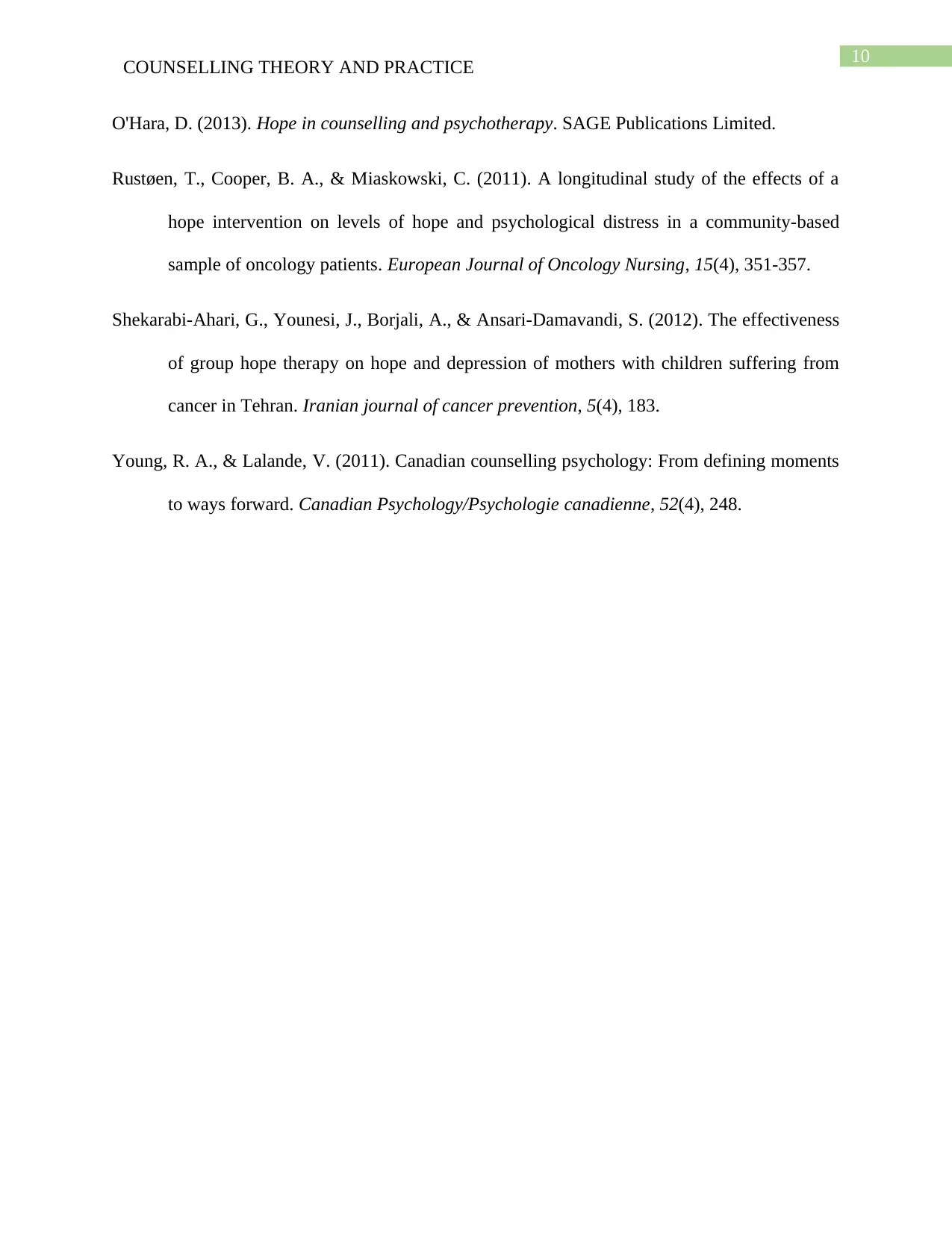
10
COUNSELLING THEORY AND PRACTICE
O'Hara, D. (2013). Hope in counselling and psychotherapy. SAGE Publications Limited.
Rustøen, T., Cooper, B. A., & Miaskowski, C. (2011). A longitudinal study of the effects of a
hope intervention on levels of hope and psychological distress in a community-based
sample of oncology patients. European Journal of Oncology Nursing, 15(4), 351-357.
Shekarabi-Ahari, G., Younesi, J., Borjali, A., & Ansari-Damavandi, S. (2012). The effectiveness
of group hope therapy on hope and depression of mothers with children suffering from
cancer in Tehran. Iranian journal of cancer prevention, 5(4), 183.
Young, R. A., & Lalande, V. (2011). Canadian counselling psychology: From defining moments
to ways forward. Canadian Psychology/Psychologie canadienne, 52(4), 248.
COUNSELLING THEORY AND PRACTICE
O'Hara, D. (2013). Hope in counselling and psychotherapy. SAGE Publications Limited.
Rustøen, T., Cooper, B. A., & Miaskowski, C. (2011). A longitudinal study of the effects of a
hope intervention on levels of hope and psychological distress in a community-based
sample of oncology patients. European Journal of Oncology Nursing, 15(4), 351-357.
Shekarabi-Ahari, G., Younesi, J., Borjali, A., & Ansari-Damavandi, S. (2012). The effectiveness
of group hope therapy on hope and depression of mothers with children suffering from
cancer in Tehran. Iranian journal of cancer prevention, 5(4), 183.
Young, R. A., & Lalande, V. (2011). Canadian counselling psychology: From defining moments
to ways forward. Canadian Psychology/Psychologie canadienne, 52(4), 248.
1 out of 11
Related Documents
Your All-in-One AI-Powered Toolkit for Academic Success.
+13062052269
info@desklib.com
Available 24*7 on WhatsApp / Email
![[object Object]](/_next/static/media/star-bottom.7253800d.svg)
Unlock your academic potential
Copyright © 2020–2025 A2Z Services. All Rights Reserved. Developed and managed by ZUCOL.





